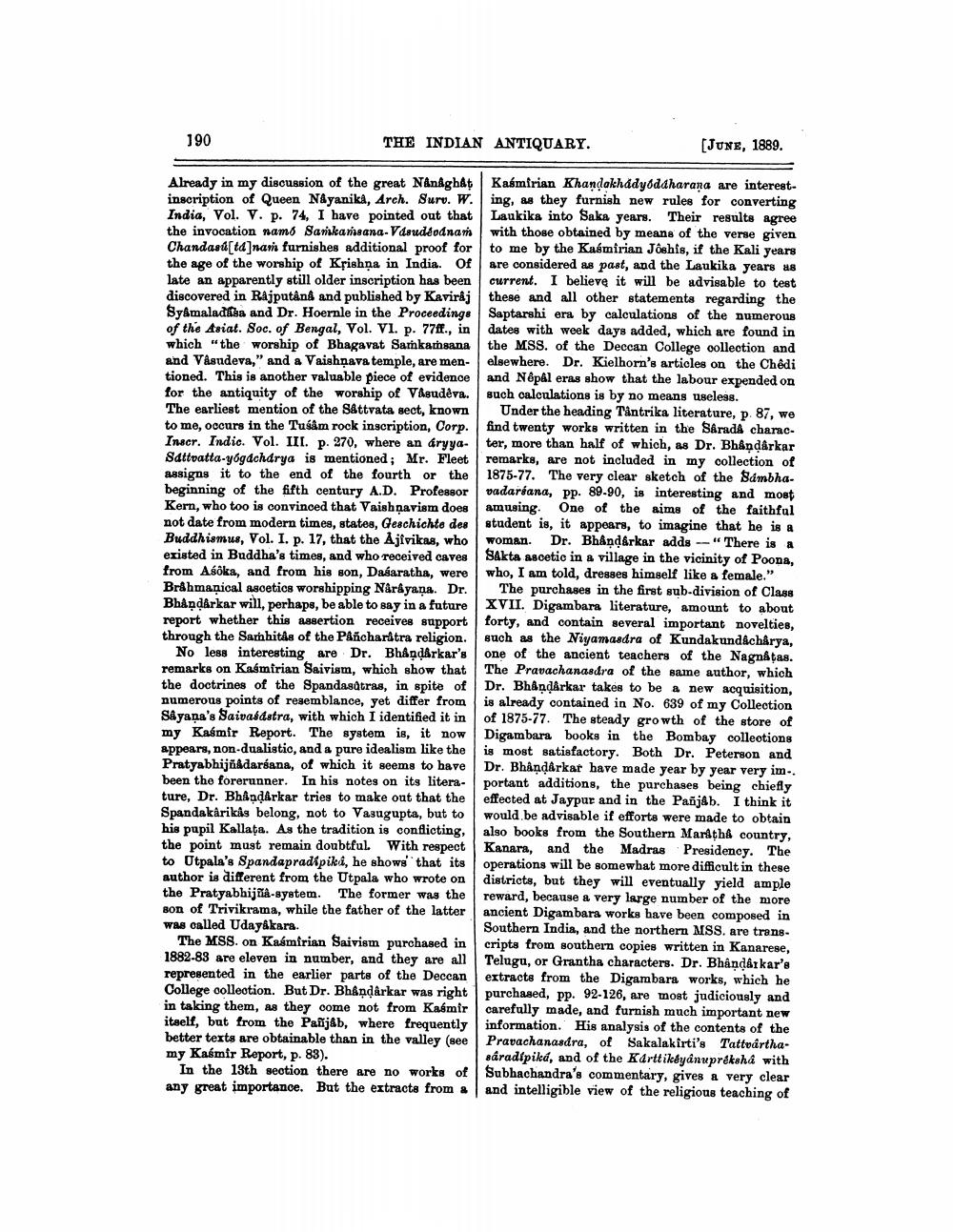________________
190
THE INDIAN ANTIQUARY.
(JUNE, 1889.
Already in my discussion of the great Nanäghåt Kaśmirian Khandakhadyoddharana are interestinscription of Queen Nayanika, Arch. Suru. W. ing, as they furnish new rules for converting India, Vol. V. p. 74, I have pointed out that Laukika into Saka years. Their results agree the invocation nams Sarkansana-Vasuddodnan with those obtained by means of the verse given Chandasú tajnan furnishes additional proof for to me by the Kasmirian Jôshis, if the Kali years the age of the worship of Krishna in India. Of are considered as past, and the Laukika years as late an apparently still older inscription has been current. I believe it will be advisable to test discovered in Rajputând and published by Kaviraj these and all other statements regarding the Syamaladása and Dr. Hoernle in the Proceedings Saptarshi era by calculations of the numerous of the Asiat. Soc. of Bengal, Vol. VI. p. 77ff., in dates with week days added, which are found in which "the worship of Bhagavat Samkansana the MSS. of the Deccan College oollection and and Vasudeva," and a Vaishnava temple, are men- elsewhere. Dr. Kielhorn's articles on the Chedi tioned. This is another valuable piece of evidence and Nepal eras show that the labour expended on for the antiquity of the worship of Vasudeva. such calculations is by no means useless. The earliest mention of the Såttvata sect, known Under the heading Tântrika literature, p. 87, we to me, occurs in the Tuśâm rock inscription, Corp. find twenty works written in the Sáradh charac. Inscr. Indic. Vol. III. p. 270, where an áryya- ter, more than half of which, as Dr. Bhåndarkar Sattvatta-yógacharya is mentioned; Mr. Fleet remarks, are not included in my collection of assigns it to the end of the fourth or the 1875-77. The very clear sketch of the Sambha. beginning of the fifth century A.D. Professor vadaríana, pp. 89-90, is interesting and most Kern, who too is convinced that Vaishnavism does amusing One of the aims of the faithful not date from modern times, states, Geschichte des student is, it appears, to imagine that he is a Buddhismus, Vol. I. p. 17, that the Ajivikas, who woman. Dr. Bhåndárkar adds -- "There is a existed in Buddha's times, and who received caves Sakta ascetic in a village in the vicinity of Poona, from Asöka, and from his son, Dasaratha, were who, I am told, dresses himself like a female." Brahmaņical ascetics worshipping När&yaņa. Dr. The purchases in the first sub-division of Class Bhåndårkar will, perhaps, be able to say in a future XVII. Digambara literature, amount to about report whether this assertion receives support forty, and contain several important novelties, through the Samhits of the Påncharitra religion. such as the Niyamasdra of Kundakundácharya,
No less interesting are Dr. Bhåndarkar's one of the ancient teachers of the Nagnâ¢as. remarks on Kasmirian Saivism, which show that The Pravachanasdra of the same author, which the doctrines of the Spandasátras, in spite of Dr. Bhåndarkar takes to be a new acquisition, numerous points of resemblance, yet differ from is already contained in No. 639 of my Collection SAyana's Saivafdstra, with which I identified it in of 1875-77. The steady growth of the store of my Kasmir Report. The system is, it now Digambara books in the Bombay colleotions appears, non-dualistio, and a pure idealism like the is most satisfactory. Both Dr. Peterson and Pratyabhijñadarśana, of which it seems to have Dr. Bhandarkar have made year by year very im.. been the forerunner. In his notes on its litera- portant additions, the purchases being chiefly ture, Dr. Bhandarkar tries to make out that the effected at Jaypur and in the Pañjab. I think it Spandakârikas belong, not to Vasugupta, but to would be advisable it efforts were made to obtain his pupil Kallaţa. As the tradition is conflicting, also books from the Southern Marath country, the point must remain doubtful. With respect Kanara, and the Madras Presidency. The to Otpala's Spandapradipiki, he shows that its operations will be somewhat more difficult in these author is different from the Utpala who wrote on districts, but they will eventually yield ample the Pratyabhijfia-system. The former was the reward, because a very large number of the more son of Trivikrama, while the father of the latter ancient Digambara works have been composed in was called Udayâkara.
Southern India, and the northern MSS. are transThe MSS. on Kasmirian Saivism purchased in cripts from southern copies written in Kanarese, 1882-83 are eleven in number, and they are all Telugu, or Grantha characters. Dr. Bhåndâr kar'e represented in the earlier parts of the Deccan extracts from the Digambara works, which he College oollection. But Dr. Bhandarkar was right purchased, pp. 92-126, are most judiciously and in taking them, as they come not from Kasmir carefully made, and furnish much important new itself, but from the Pañjab, where frequently information. His analysis of the contents of the better texts are obtainable than in the valley (see Pravachanasdra, of Sakalakirti's Tattvarthamy Kaśmir Report, p. 83).
sáradipiká, and of the Karttik&yánupréksha with In the 13th section there are no works of Subhachandra's commentary, gives a very clear any great importance. But the extracts from and intelligible view of the religious teaching of




